1. France, 1900s: painted backdrops, tableau style, and colour
Guillaume Tell (1903)
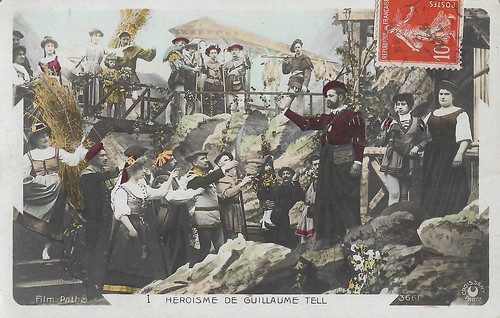
French postcard for Théâtre Pathé Grolée, Lyon, by Croissant, Paris, series 3661. Photo: Film Pathé. Edmond Boutillon as Gessler in Guillaume Tell/Wilhelm Tell (Lucien Nonguet, 1903). Unknown is who played Tell. Sets: Vincent Lorant-Heilbronn.
The Pathé film Guillaume Tell (1903) narrates the historic legend of Swiss free fighter Wilhelm Tell. In 1307, the Habsburg ruler Gessler forces Tell to shoot an apple from the head of his son.
Un drame à Venise (1906)

French postcard by Croissant, Paris, no. 3672. Photo: Film Pathé. Publicity still for Un drame à Venise/Venetian Tragedy (Lucien Nonguet, 1906). Sent by mail in 1917. Caption: Au nom de l'honneur.
In this early Pathé Frères production, one of the rich palaces of Venice is the setting for a drama of smouldering love and hate. In the Middle Ages, an important lord is not loved by his wife. Despite the sumptuous wealth her husband surrounds her with, the noble dame can only think about a young and handsome Romeo. The lover is surprised by the husband, who kills him and Romeo ends in a canal. The noble lady escapes her death when her husband is stopped by her miraculous beauty... The film is partly in colour.
2. Italy, 1910s: spectacle, scenery, and sensation
La Gorgona (1914). A plight forsaken

Italian postcard. Photo: Ambrosio Film. Publicity still for the Italian silent film La Gorgona (Mario Caserini, 1914), scripted by Arrigo Frusta and starring Annibale Ninchi and Madeleine Céliat. The film was based on a play by Sem Benelli. The film was released in Rome on 9 March 1915. The man on the left on this card seems to be Ninchi.
In La Gorgona, Pietro Pisano's daughter, Spina (Madeleine Céliat), a modern Vestal, holds the fire lighted for the return of her fellow citizens fighting the Saracens in the Orient. But the Florentine Lamberto Fiquinaldo (Annibale Ninchi) falls in love with her, causing her to break her holy plight. Eventually, this leads to double suicide by the couple. Allan Kardec in La Cinematografia italiana ed estera (15/30.4.1915) praised the beauty and grandeur of the compositions of the film and the performance of the single actors and the extras.
La disfida di Barletta/Ettore Fieramosca (1915). Nationalist propaganda during WWI

Italian postcard. Photo: Pasquali Film. Giovanni Cimara in La disfida di Barletta/Ettore Fieramosca (Umberto Paradisi, 1915). Caption: In the name of the Italian armies, Ettore Fieramosca challenges the Spanish Baron la Motta, who has insulted Italy.
La disfida di Barletta/Ettore Fieramosca (Umberto Paradisi, 1915) was based on a literary action epic by Massimo D'Azeglio. During the Risorgimento and the rise of Fascism, Ettore Fieramosca was presented as a national hero and became the subject of national celebrations. D'Azeglio wrote his novel in 1833 novel in an effort to boost Italian patriotism.
Attila (1918). The barbarism of the enemy
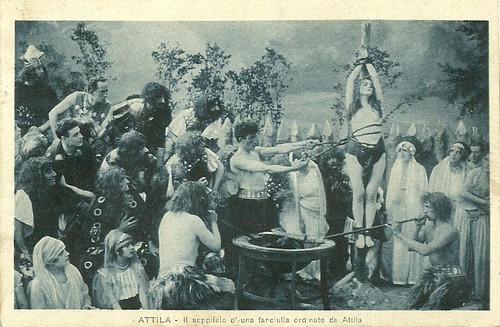
Italian postcard. Photo: Ambrosio film. Febo Mari as the ruthless Attila the Hun in Attila (Febo Mari, 1918). Translation caption: The torture of a girl by orders of Attila.
Attila (Febo Mari, 1918) came out in Italy in February 1918, during the First World War. Pier da Castello in the Italian magazine La vita cinematografica drew a comparison between Attila the Hun and Emperor Wilhelm II, who was considered as the culprit of the First World War and its massive slaughter. Da Castello indicated that Mari’s film appealed to the call of the government to make patriotic films. These had to show audiences why the blood-shedding was necessary. He forgave Mari’s ‘playing’ with history.
3. Germany, 1920s: medieval legends & stars in Shakespeare adaptations
Die Nibelungen (1924). The death of Siegfried

German postcard by Uvachrome, Serie 405, no. 5487. Image: watercolour after a famous still of Paul Richter in part 1 of Fritz Lang's Die Nibelungen (1924), based on the Medieval Nibelungen-Lied.
Die Nibelungen (Fritz Lang, 1924) is one of the masterpieces of the Weimar cinema. It is the tale of the legendary German hero Siegfried, son of King Siegmund. Siegfried (Paul Richter) is killed by the spear of Hagen Tronje, right on the only weak spot on his back. After bathing in dragon blood, he had become invincible, but a leaf fallen from a tree had left one spot open on his back. It is right there where the spear strikes the hero.
Die Nibelungen (1924). Rudolf Klein-Rogge as King Etzel (Attila)

Yugoslavian (Croatian) postcard. Photo: Balkan-Film, Zagreb. Rudolf Klein-Rogge as Lord Etzel, King of the Huns, in Fritz Lang's medieval legend Die Nibelungen (1924).
After Siegfried's murder, his wife Kriemhild seeks revenge and marries Etzel, the King of the Huns. She tries to persuade Etzel and the other Huns to kill Hagen, the murderer of Siegfried, but Hagen is protected by her brothers. A fierce battle begins to force her brothers to give Hagen to her.
Die Nibelungen (1924). A Jugendstil and Art Déco vision of the Middle Ages

German postcard by Ross Verlag, no. 676/4. Photo: Decla-Ufa-Film. Rudolf Rittner as Rüdiger von Bechlaren in part II of Fritz Lang's historical drama Die Nibelungen (1924).
The geometric patterns in the costumes and sets were inspired by book illustrations for a 1908-1909 edition of 'Die Nibelungen', edited at Gerlachs Jugendbücherei. These illustrations were by the Viennese artist Carl Otto Czeschka.
Othello (1922). The Middle Ages according to Shakespeare according to Ufa

French postcard by Edition de la Cinématographie-Française, Paris. Photo: G.P.C. Emil Jannings as Othello and Werner Krauss as Jago in Othello (Dimitri Buchowetzki, 1922).
The German silent film Othello (Dimitri Buchowetzki, 1922) is based on William Shakespeare's classic stage play of jealousy and deceit. Werner Krauss plays the treacherous Iago, who plans to ruin the life of Othello (Emil Jannings) by provoking him to jealousy. Wes Connors at IMDb: "The production is nicely staged, with everyone finding their marks. Its costumes and sets are very well designed. The adaptation is faithful enough to Shakespeare's envious storyline. But, watching two overly grand old actors is the film's main calling card, presently."
Hamlet (1921). Asta Nielsen crossdressing as Hamlet
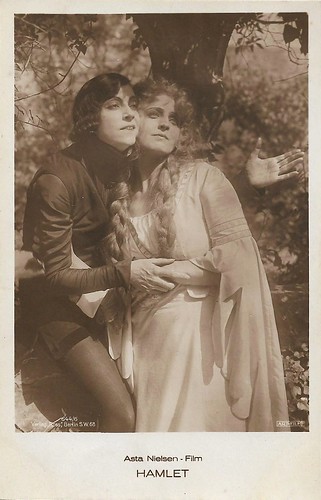
German postcard by Ross Verlag, Berlin, no. 644/6. Photo: Art-Film. Asta Nielsen-Film. Asta Nielsen as Hamlet and Lilly Jacobsson as Ophelia in Hamlet (Svend Gade, Heinz Schall, 1921). Asta Nielsen had produced the film herself.
Gary Morris in Bright Lights Film Journal: "Asta brings a subtle twist to her version not by playing a man, but by playing a woman disguised as a man, adding another level of gender complexity. Hamlet was based less on William Shakespeare than on a popular book of the time that said Hamlet was actually a girl forcibly raised as a boy in order to provide an heir to the Danish throne. At first, the effect is more puzzling than effective, but the actress's strategy becomes evident in sexually charged scenes between Asta/Hamlet and Horatio, who caress and coddle each other in what surely appeared to viewers of the time (as it does to modern audiences) as a gay tryst. Asta brilliantly imparts the gender-unstable nature of the character in these scenes with Horatio and others with Fortinbras, whose encounters with Hamlet are also clearly coded as gay. The actress's effortless creation of these subtle, sympathetic homosexual tableaux gives a tremendous vitality to this production. The fact that the film was truly hers — being the first film she made with her own production company — shows just how daring and modern she was."
Der Kaufmann von Venedig (1923). Henny Porten as Portia in Shakespeare's Merchant of Venice

German postcard by Ross Verlag, no. 658/4. Photo: Peter Paul Felner-Film Co. Henny Porten as Porzia/ Portia and Lia Eibenschütz as Jessica in Der Kaufmann von Venedig/The Merchant of Venice (Peter Paul Felner, 1923). The man far right is Carl Ebert as Antonio.
Der Kaufmann von Venedig/The Merchant of Venice is a free silent film adaptation of Shakespeare's 'The Merchant of Venice'. It was released in the United States in 1926 as The Jew of Mestri. The film was made on location in Venice, with scenes and characters added which were not in the original play. Directors of photography were Axel Graatkjær and the future Hollywood director Rudolph Maté. The only surviving copy of the film is an English one which is two reels shorter than the German version.
4. Archetypes: Robin Hood & Joan of Arc
Robin Hood (1922). Douglas Fairbanks
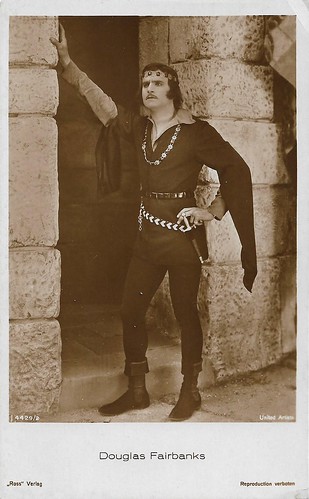
German postcard by Ross Verlag, no. 4429/2, 1929-1930. Photo: United Artists. Douglas Fairbanks in Robin Hood (Allan Dwan, 1922).
The Adventures of Robin Hood (1938). Errol Flynn
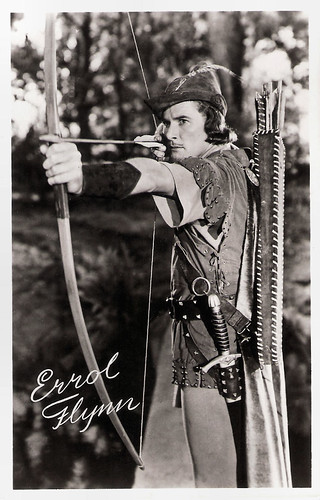
Dutch card. Photo: Warner Bros. Errol Flynn in The Adventures of Robin Hood (Michael Curtiz, William Keighley, 1938).
Robin Hood (Wolfgang Reithermann, 1973). The Disney version
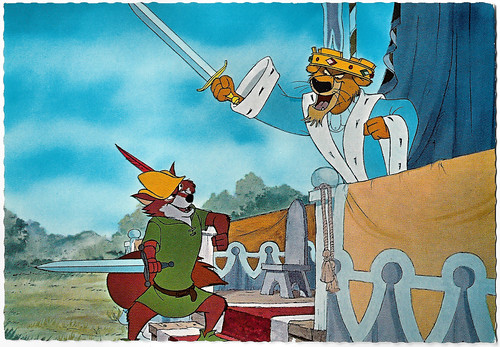
Italian postcard by Corna, Brussels, no. 5 / 3303. Image: Walt Disney Productions. Publicity still for Robin Hood (Wolfgang Reitherman, 1973).
The twenty-first Disney animated feature film Robin Hood (Wolfgang Reitherman, 1973) is an imaginative version of the Robin Hood legend. Fun and romance abound as the swashbuckling hero of Sherwood Forest and his valiant sidekick Little John plot one daring adventure after another to outwit the greedy Prince John.
Robin Hood - Prince of Thieves (1991). Kevin Costner

French postcard, no. A085. Kevin Costner in Robin Hood - Prince of Thieves (Kevin Reynolds, 1991).
La Passion de Jeanne d'Arc (1927). A film which is all about faces. Renée Falconetti as Joan

French postcard by Editions Cinémagazine, no. 519. Renée Falconetti in La passion de Jeanne d’Arc (Carl Theodor Dreyer, 1928).
Joan of Arc (1948). The Ingrid Bergman version

Italian postcard by Zincografica Fiorentina. Photo: RKO Radio Films. Ingrid Bergman in Joan of Arc (Victor Fleming, 1948).
5. The Middle Ages according to TV
Ivanhoe (1958-59). Roger Moore in the popular Walter Scott adaptation

Dutch postcard by Int. Filmpers P.D.B., Amsterdam. Photo: Roger Moore in the TV series Ivanhoe (1958-1959).
Thierry la Fronde (1963-66). Jean-Claude Drouot as a French Robin Hood

French postcard by Éditions d'art Yvon, Arcueil, no. 2. Photo: O.R.T.F. / Télé France Film / Photo Bruguière. Jean-Claude Drouot in the TV series Thierry la Fronde (1963-1966).
Floris (1969). Rutger Hauer as the Dutch Robin Hood

Dutch collectors card by Monty, no. 19, 1970. Photo: Gerard Soeteman. Rutger Hauer in the TV series Floris (Paul Verhoeven, 1969).
The Dutch TV series Floris (Paul Verhoeven, 1969) was inspired by Ivanhoe and Thierry la Fronde, and also by the Belgian TV series Johan en de Alverman. The enormous success of Floris jumpstarted the successful careers of director Paul Verhoeven, scriptwriter Gerard Soeteman and of course Rutger Hauer. Hauer played the exiled knight Floris van Rosemondt. With his Indian friend Sinhala, he tries to get his birthright papers back from Maarten van Rossem, an evil lord.
Body Language. The body in medieval art
Because of the Dutch lockdown, alas, the physical exhibition cannot be visited anymore. But you can take a tour with guest curator Wendeline van Welie on YouTube (in Dutch), or you can float through the exhibition with this short Vimeo film. If you want to attend Ivo's online lecture, please visit the site of the Catherijneconvent.
No comments:
Post a Comment